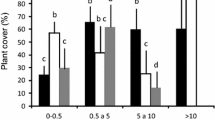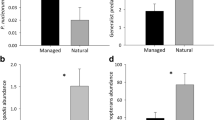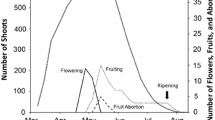Abstract
In this paper I will touch on some of the patterns and processes that have come to light in an on-going study of how the insects that eat seeds in tropical vegetation influence the structure of that vegetation and the characteristics of its individual members, and how the characteristics of the plants influence the insects. This study began in 1964 in the lowlands of the state of Veracruz, Mexico. While trying to understand the population dynamics and interdependency of obligate acacia-ants and their acacias (Janzen 1967), I was struck by the thoroughness with which the bruchid Acanthoscelides oblongoguttatus decimated the seed crops of Acacia cornigera. This swollen-thorn acacia was extremely common as a result of farming and grazing practices, and it produced far more fruits than the local community of dispersal agents would eat (a thorough study of dispersal agents was not made, but at least the Plain-tailed Brown Jay, Psilorhinus mexicanus, Black- headed Saltator, Saltator atriceps, and Grayish Saltator, Saltator coerulescens, ate seeds along with the pulp and defecated living seeds). While most of the A. cornigera population bore flowers in the later part of the dry season (March, April) and mature fruits about ten months later, individuals in almost any reproductive stage could be found at any time of year in an area as small as a few hectares. The pods remained on the acacia in a stage susceptible to bruchid oviposition for as long as two to three months. Attack was heavy and continuous, both from beetles that could have emerged from other pods on the same acacia, and from beetles coming from other A. cornigera out of fruiting synchrony. Only very broad synchrony of flowering and fruiting occurred in the highly mixed and variously disturbed habitats (roadsides, back yards, various age corn fields, pastures, fencerows, creekbanks, marshes).
Access this chapter
Tax calculation will be finalised at checkout
Purchases are for personal use only
Preview
Unable to display preview. Download preview PDF.
Similar content being viewed by others
Literature Cited
Bell, E. A., and D. H. Janzen. 1971. Medical and ecological considerations of L-DOPA and 5-HTP in seeds. Nature 229: 136–137.
Center, T. D., and C. D. Johnson. 1974. Coevolution of some seed beetles ( Coleoptera: Bruchidae) and their hosts. Ecology 55: 1096–1103.
Evans, R. J., and S. L. Bandemer. 1967. Nutritive value of legume seed proteins. J. Agric. Food Chem. 15: 439–443.
Gwynne, M. D. 1969. The nutritive values of Acacia pods in relation to Acacia seed distribution by ungulates. East Afr. Wildl. J. 7: 176–178.
Janzen, D. H. 1966. Coevolution of mutualism between ants and acacias in Central America. Evolution 20: 249–275.
Janzen, D. H. 1967. Interaction of the bullfs horn acacia (Acacia cornigera L.) with an ant inhabitant (Pseudomyrmex ferruginea F. Smith) in eastern Mexico. U. Kans. Sci. Bull. 47: 315–558.
Janzen, D. H. 1969. Seed-eaters versus seed size, number, toxicity and dispersal. Evolution 23: 1–27.
Janzen, D. H. 1970. Herbivores and the number of tree species in tropical forests. Amer. Natur. 104: 501–528.
Janzen, D. H. 1971a. Seed predation by animals. Annu. Rev. Ecol. Syst. 2: 465–492.
Janzen, D. H. 1971b. The fate of Scheelea rostrata fruits beneath the parent tree: predispersal attack by bruchids. Principes 15: 89–101.
Janzen, D. H. 1971c. Escape of juvenile Dioclea megacarpa (Leguminosae) vines from predators in a deciduous tropical forest. Amer. Natur. 105: 97–112.
Janzen, D. H. 197Id. Escape of Cassia grandis L. beans from predators in time and space. Ecology 52: 964–979.
Janzen, D. H. 1972. Escape in space by Sterculia apetala seeds from the bug Dysdercus fasciatus in a Costa Rican deciduous forest. Ecology 53: 350–361.
Janzen, D. H. 1973a. Community structure of secondary compounds in plants. Pure Appl. Chem. 34: 529–538.
Janzen, D. H. 1973b. Comments on host-specificity of tropical herbivores and its relevance to species richness, p. 201–211. In V. H. Heywood, ed. Taxonomy and ecology. Syst. Assoc. Special Vol. No. 5. Academic Press, London.
Janzen, D. H. 1973c. Sweep samples of tropical foliage insects: effects of seasons, vegetation types, elevation, time of day, and insularity. Ecology 54: 687–708.
Janzen, D. H. 1973d. Tropical agroecosystems. These habitats are misunderstood by the temperate zones, mismanaged by the tropics. Science 182: 1212–1219.
Janzen, D. H. 1974a. Swollen-thorn acacias of Central America. Smithson. Contrib. Bot. No. 13. 131 p.
Janzen, D. H. 1974b. The role of the seed predator guild in a tropical deciduous forest; with some reflections on tropical biological control, p. 3–14. In D. Price Jones and M. E. Solomon, eds. Biology in Pest and Disease Control. Blackwell Sei. Pub., Oxford.
Janzen, D. H. 1974c. The deflowering of Central America. Natur. Hist. 83: 48–53.
Janzen, D. H. 1975a. Sweep samples of tropical deciduous forest foliage-inhabiting insects: seasonal changes and inter-field differences in adult bugs and beetles. Ecology. In press.
Janzen, D. H. 1975b. Intra- and inter-habitat variation in Guazuma ulmifolia (Sterculiaceae) seed predation by Amblycerus cistelinus (Bruchidae) in Costa Rica. Ecology. In press.
Janzen, D. H., M. Atarroff, M. Fariñas, S. Reyes, N. Rincon, A. Soler, P. Soriano, and M. Vera. 197 5. Changes in the arthropod community along an elevational transect in the Venezuelan Andes. In press.
Janzen, D.. H., and C. M. Pond. 1975. A comparison, by sweep sampling, of the arthropod fauna of secondary vegetation in Michigan, England and Costa Rica. Trans. R. Entomol. Soc. Lond. In press.
Johnson, C. D. 1973. A new Acanthoscelides from Indigofera ( Coleoptera: Bruchidae). Col. Bull. 27: 169–174.
Johnson, R. M., and W. D. Raymond. 1964. The chemical composition of some tropical food plants: II. Pigeon peas and cow peas. Trop. Sci. 6: 68–73.
Liener, I. E. 1974. Phytohaemagglutinins: their nutritional significance. J. Agr. Food Chem. 22: 17–22.
Long, A., and P. S. Martin. 1974. Death of American ground sloths. Science 186:638–640. Magnus, K. E., and C. E. Seaforth. 1965. Samanea saman Merrill: the rain tree. A review. Trop. Sci. 7: 6–11.
Rehr, S. S., P. P. Feeny, and D. H. Janzen. 1973a. Chemical defence in Central American non-ant-acacias. J. Anim. Ecol. 42: 405–416.
Rehr, S. S., D. H. Janzen, and P. P. Feeny. 1973b. L-Dopa in legume seeds: a chemical barrier to insect attack. Science 181: 81–82.
Rehr, S. S., E. A. Bell, D. H. Janzen, and P. P. Feeny. 1973c. Insecticidal amino acids in legume seeds. Biochem. Syst. 1: 63–67.
Rosenthal, G. A. 1972. Investigations of canavanine biochemistry in the jack bean plant, Canavalia ensiformis (L.) DC. II. Canavanine biosynthesis in the developing plant. Plant Physiol. 50: 328–331.
Sevilla-Eusebio, J., J. C. Mamaril, J. A. Eusebio, and R. R. Gonzales. 1968. Studies on Philippine leguminous seeds as protein foods. 1. Evaluation of protein quality in some local beans based on their amino acid patterns. Philipp. Agric. 52: 211–217.
Wilson, D., and D. H. Janzen. 1972. Predation on Scheelea palm seeds by bruchid beetles: seed density and distance from the parent palm. Ecology 53: 954–959.
Author information
Authors and Affiliations
Editor information
Editors and Affiliations
Rights and permissions
Copyright information
© 1975 Plenum Press, New York
About this chapter
Cite this chapter
Janzen, D.H. (1975). Interactions of Seeds and their Insect Predators/Parasitoids in a Tropical Deciduous Forest. In: Price, P.W. (eds) Evolutionary Strategies of Parasitic Insects and Mites. Springer, Boston, MA. https://doi.org/10.1007/978-1-4615-8732-3_8
Download citation
DOI: https://doi.org/10.1007/978-1-4615-8732-3_8
Publisher Name: Springer, Boston, MA
Print ISBN: 978-1-4615-8734-7
Online ISBN: 978-1-4615-8732-3
eBook Packages: Springer Book Archive




